Photo: Paul Rudderow
A fairly comprehensive win highlighted Philadelphia Union’s potential and problems Sunday night. More importantly, the match gave a clearer sense of how Philadelphia, with Maurice Edu in back, can approach the US Open Cup final against Sporting Kansas City.
Barnetta and Maidana
The most interesting tactical question going into Sunday evening was how Cristian Maidana and Tranquillo Barnetta would interact on the pitch. Jim Curtin risked losing the middle defensively if he sat Maidana central, but the Argentine’s contributions can be stunted when he is locked on the wing. Barnetta, on the other hand, would like to stay in the middle and has been growing into the role in Maidana’s absence.
In the end, it hardly mattered. The Houston midfield provided a classic rendition of a game of tag at elementary school recess, and Philly did not have to be especially precise to pass through it easily. Yet there is still information to be gathered from the interplay of Maidana and Barnetta.

Union (L) and Houston passing charts during mins 1-20. That’s ugly from Philly, but they recovered. The Dynamo were intent on going up the right from the start.
First, they did not act out the most predictable movements, with Barnetta drifting ever-further inside as Maidana curls out left with increased frequency. Instead, they sought to overload Sheanon Williams, playing out of position at left back. Philadelphia attacked relentlessly up the right, and Maidana’s positioning was key to it all. The playmaker would slide out to the right touchline, pulling Ricardo Clark (in the first half, Luis Garrido in the second) with him and opening an enormous hole in the center. Traditionally, the Union have struggled to attack that empty space, but on Sunday Barnetta immediately darted inside from the left, allowing Vincent Nogueira to stay in his preferred deeper positions.
Interestingly, the goal was not to then push Fabinho high into Barnetta’s abandoned space. With Maidana on the right touchline, Sebastien Le Toux made vertical runs through the channel, making him more dangerous than when he makes the same runs out wide. Now Le Toux was directly threatening AJ Cochran, who is not yet experienced enough to lead a step forward to catch the Frenchman offsides. Le Toux’s runs opened gaps for Barnetta and the excellent CJ Sapong in the middle, with Nogueira arriving late from time to time (though too rarely given the space Houston left above the box).
The entire sequence was successfully executed more than once in the first half — and the basic shape, with Maidana on the wing and Le Toux running inside of him — was enough to convince Owen Coyle to add Luis Garrido to the mix at halftime. Garrido was a necessary addition because Brad Davis, Oscar Boniek Garcia, and Miranda were almost uncomfortably out of position defensively, meaning one sharp pass from the right could easily open up the Houston defense. When Philly moved the ball quickly, they almost always created enormous holes in a scrambling Dynamo back line that completely lacked cover.
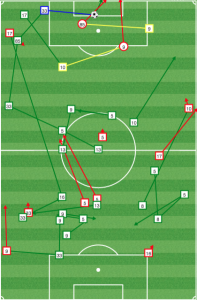
Philly absorbed pressure to start the second half. But when they countered, they did it efficiently – All Union passes from mins 55-65
Can Philly execute a similar offense again Kansas City?
It will be difficult, but doable. It is doable because Peter Vermes’ 4-3-3 does cede space on the flanks following turnovers. However, it will be difficult because Peter Vermes’ 4-3-3 is built to press when it loses the ball. And it can be very, very good at it.
Interestingly, that daunting press has become the make-or-break part of the game for Kansas City in recent weeks. Who can blame Vermes for going after the ball when he has the likes of Dom Dwyer, Benny Feilhaber, Graham Zusi, and Paulo Nagamura to call on? But in recent weeks the midfield — and Dwyer at times — have shown a tendency to overpursue, leaving the center of the pitch in an effort to close down the ball. This aggression has made Sporting look much worse than they actually are. A 0-0 draw with Portland was notable for how often Diego Valeri was able to slip into gaps behind the normally-reliable Nagamura. Valeri had an extremely efficient match, popping up sideline to sideline as the KC press left spaces in front of the defense but failed to prevent Portland from playing passes into those holes.
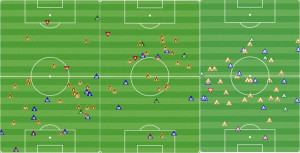
KC vs Portland (L; draw), Orlando (C; loss) and Dallas (R; win). The Dallas match was clearly the most balanced defensive performance of the three. Against Portland, Nagamura was pulled to the right. Against Orlando, an early goal convinced KC to press extremely high, but the pressure came at the expense of the team’s shape.
Four days later, Kansas City went behind early and executed a breathtaking press until Krisztian Nemeth tied the match midway through the second half. That pressing may have led to KC’s quick collapse, as Bryan Rochez put Orlando back ahead seven minutes later and Winter sealed the game six minutes after that. The Sporting midfield put in an absurd amount of work in the Orlando half, closing down OCSC’s dangerous fullbacks quickly. But the cost was paid in the center, where — and this makes zero sense — Lewis Neal had enough time to look like a serviceable replacement for Kaka in an offensive midfield role. Think about that sentence (not too hard, the fabric of spacetime is only so strong).
For Philadelphia, handling this press can take two forms. The likely form it will take is that of Maurice Edu, offensive lynchpin. If KC presses well, Edu’s ability to start the offense out of the back will be impossible to overstate. Dwyer is a defensive workhorse, and Edu will need to be quick, accurate, and creative since any error will be pounced on by the ever-dangerous whineybaby Feilhaber.
The second form is what the Union showed in Houston. Overload one side of the pitch — likely the right — and pull Nagamura out of the middle. With Barnetta and Maidana in front of the spritely Nogueira, Philadelphia finally has the technicians to build possessions in the opponent’s half. It won’t be easy against Kansas City, who certainly will not allow the oft-jumpy Ray Gaddis time to pick out passes. But it is possible. And it is clear that Barnetta and Maidana can co-exist and make each other more dangerous by playing the sort of interchangeable roles that previously existed only in the idyllic responses of Jim Curtin’s press conferences.
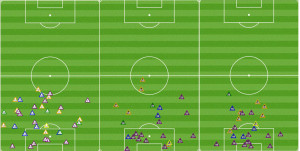
Union CBs vs Houston (L), during the win over Montreal (C) and in the win over San Jose (R). Look at how much deeper the CBs drop to defend (even when the Union win) when Edu is absent.
What about in back: The endless Edu debate
Sure is nice to have Maurice Edu back in defense. And, relatedly, sure is worrying to hear Jim Curtin remain noncommittal about leaving the Union captain back there.
This brings up a debate that is near-impossible to solve. Where does Maurice Edu belong on the field? The problem, distilled down to its essence, is this: the current incarnation of Maurice Edu is so good at soccer. But throughout his career, since emerging from Maryland as a more mature, cultured player than MLS knew how to handle, Edu has always had the potential to be so much better. And even as he hits his peak years, it is impossible to shake the notion that Edu is about to put it all together and become even more than he already is (which, remember, is flippin’ excellent most of the time).
And so Jim Curtin and the coaching staff remain torn between leaving Edu in the back line, where he a) can dominate, b) sometimes turns off, and c) would probably prefer not to play and moving him into midfield where he a) dominates less often, b) tries to do too much, and c) doesn’t fit the Union’s best system. Leaving him in the back seems obvious. But like Curtin said in his presser, the requirements of playing center back can be a walk in the park to Edu.
This perception that Edu can do more leads to the belief that he should be doing more. As in, actively doing stuff. In back, Edu’s contributions often take the form of preventing things from happening. This is very necessary, but it can make Edu seem underutilized because he isn’t gliding through opposing midfields, driving the team forward the way a player of his gifts seems like he should.
This trade-off between putting Mo Edu in a position where he can best help the team versus putting Mo Edu in a position where he can fulfill his potential has plagued the Union captain’s career. When Philly put Edu in the back, people immediately asked why Edu hadn’t been developed as a central defender his whole career. It’s a fair question, but the answer is also fairly obvious: If you were a coach and Maurice Edu was your player, and you watched him every practice, putting him in defense must feel like having a Ferrari — or, perhaps, a Lamborghini — and making the decision to only drive it in school zones. Are you really getting the most out of that car?
Extending the Ferrari metaphor too far
Curtin and his staff have to see the truth: This is not a question of where to drive the Ferrari. It is a question about whether to drive a Ferrari in a school zone or not drive one at all. Because in the end, that car is getting you where you need to go. And the waterfall effect of moving Edu out of defense will keep Philadelphia from getting where they need to go (which is to the playoffs. Consistently.). Not only does Edu solidify the back line and allow a team short on passers to move the ball out of the back, moving him forward means sacrificing a true defensive midfielder. Every time the Union have made that sacrifice, they have regretted it. I can’t believe I’m writing this… but Philly should listen to George W. Bush on this one.
Player ratings
John McCarthy – 4
Sloppy with the punching, and missed on the corner that eventually became Houston’s best opportunity. But McCarthy kept the clean sheet. His distribution needs serious work. The Union spend too much time absorbing pressure without their goalie connecting only three of 12 kicks out of the back.
Ray Gaddis – 7
Houston spent much of the night attacking the Union left, which meant Gaddis could focus on straightforward defending and short passing. And he did well. By overloading the right side, Philly took the onus off Gaddis to get forward, and Maurice Edu smartly did not play Gaddis into pressure out of the back.
Maurice Edu – 7
A very steady performance was exactly what the Union needed out of their returning captain. Edu made one mistake on the night — a misplaced short pass to Richie Marquez — but otherwise he showed the poise on the ball his team needed. Being able to bypass Will Bruin and walk the ball forward allowed the Union to have an extra man in the middle to start attacks, and the Houston midfield struggled to control space in the middle third as a result.
Richie Marquez – 6
Nothing spectacular from the young CB, but he flashed the speed and physicality that make him such an intriguing long-term solution in back. Houston was dedicated to coming up the left through Boniek Garcia and Miranda, but Fabinho stayed home and Marquez continually ensured that pressure up the wing did not translate into chances in the danger zone atop the Union box.
Fabinho – 6
This was the type of performance it did not seem like Fabinho would ever deliver. Until midway through this season, the Brazilian just did not seem to understand that the Union’s tactics did not allow a fullback to maraud first and defend later. Since learning to pick his spots, Fabinho has become a reliable defender, albeit with lapses that could be attributable to bad habits or an endless run of games dictated by a lack of depth.
Michael Lahoud – 7
Look, if you’re going to bring that weak sauce, Mike Lahoud can make defensive midfield look as easy, breezy, and beautiful as a Cover Girl commercial. Lahoud was unbothered by the Dynamo in the first half and clamped down in the second, keeping Erick Torres out of the game and generally making Ricardo Clark’s central runs useless. The passing continues to improve for Lahoud, who recognized the team’s desire to play up the right and sprayed balls that way as he recovered them in the second half.
Vincent Nogueira – 7
With Barnetta tucking inside, Nogueira spent his evening as the first outlet out of the back, checking deep and making the first pass that allowed Philly to bypass the Houston defense. It was not the fancy or noticeable stuff that makes a player stand out, it was all the little stuff that turns a clunky offense into a functional one.
Tranquillo Barnetta – 8
It is delightful and ironic that on the night Sheanon Williams returned to PPL Park, Tranquillo Barnetta showed the fire that has been missing since the Sheanomenon was in peak form. When Nogueira was sliced down, Barnetta showed the emotional response that Union fans desperately want from their team. Did he shuffle too close to the edge? Maybe. But man, it was nice to see a player show that kind of passion. The Union are banking on Barnetta rounding into form by next March and all signs look good so far. The movement is still impressive, and the passing is catching up. The interesting aspect of Barnetta’s tenure with the Union will be the extent to which he wants the game to form around him versus the extent to which he is able to facilitate the game that best fits the rest of the roster. Right now, Philly is a much better team with Chaco Maidana as the creative hub. Barnetta recognized this against Houston and worked to free up Maidana instead of cannibalizing his space and time on the ball. A very savvy, intelligent performance.
Sebastien Le Toux – 7
Le Toux gets into trouble when he wants to be a part of the action but can’t find a way in. He overpursues, presses alone, drifts too high and central without the ball, and generally tries to do too much. On Sunday, the Union brought the game to Le Toux, playing up the right side and allowing him to do what he does best — put pressure on the defense with vertical running. He paid back the favor with an assist, though he should have added at least one goal.
Cristian Maidana – 6
Lots of time on the ball on the right meant Maidana was able to have a heavy influence on the match. The next step is to mix it up a bit more and get Maidana in deep central positions so he can play balls through the defense instead of in front of it. This was difficult against a Houston side that sat so deep, but it should be the next step in Maidana’s growth now that he has more technical players around him.
CJ Sapong – 7
Great, hard work pays off with a goal. Sapong is just too much to handle in the box, and he showed it by running over Sheanon Williams en route to his ninth goal of the season.
Substitutes
Conor Casey – 6
When Conor Casey comes on with a lead, he should be checking in, holding up the ball, and challenging in the air so the other side can’t keep coming right back down the Union’s throat. Yep, yep, and yep.
Geiger counter
Juan Guzman – 6
Let the game flow and correctly carded the extremely disappointing Giles Barnes for simulation. His handling of the foul on Nogueira that got Barnetta worked up was spot on, though Miranda should have received a caution for repeated infringement.
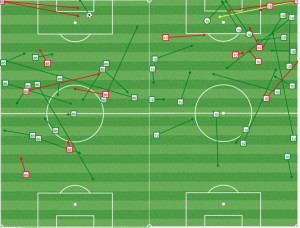
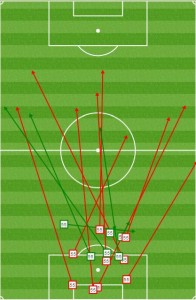
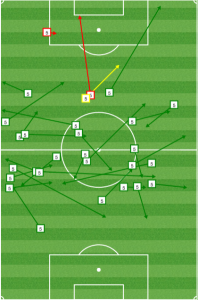
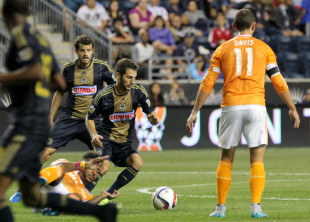

One of the frequent knocks on Maidana is that he isn’t one to run back and defend.
.
I don’t have data to back it up, only my observations from the River End, but I did notice him in a defensive position more than I had in the last few pre-spitgate games.
.
I only hope that the interplay between Barnetta and Maidana continues. They really do complement each other, and as they get more familiar and more comfortable with each other, their fluid movements around the pitch will open up the field more.
This got me more stoked for the Final than anything yet. This game meant nothing, as even if mathematically possible there is no way they make the playoffs, and yet they still came out and played well and grabbed the win. It’s infuriating because it makes me wonder where this has been the past few weeks, but at the same it’s exactly the right time to get hot and peak on the 30th. They can win that game, and this is the first time in a long time that I feel strongly about those words.
Maurice Edu made a poor decision to play cute with the ball, 1v1 with the opposing striker, in his own penalty area. He kept the ball, but that’s a mistake in my book: a high-risk-low-reward decision.
Richie Marquez is just great. Pay him. Lock him down.
CJ gets fouled repeatedly and almost never gets a call. WTF?
Barnetta Nogueira Maidana in the midfield and I’m happy.
that was a close one for sure…kept his cool though.
Just because it didn’t explode this time does not advocate for the continued practice of juggling nitroglycerin.
I needed this line when I had teenagers.
Great recap and analysis as always. Credit where credit is due to on Guzman’s score as a referee. He was decisive and I can’t remember any head scratchers. He called a nice game in the middle. That has to be one of the higher Geiger counter scores in quite a while.
Also agree with your take on Edu. I never got the amount of noise surrounding Edu earlier this year, but maybe it is that feeling that it looks a bit too easy for him, that he might have another gear, etc. I just know we’re a MUCH better team with him out there.
Only criticism from me is Miranda’s persistent fouling not getting a yellow as Adam noted. Otherwise was a good game from the ref.
Guzman good, but very troubling that he allowed players to use their opponents as launching pads when jumping for contested head balls. Some of those incidents were so obvious, it makes you wonder. But overall, a much steadier job than 90% of refs we see. Worth a return engagement.
I remember the first match I watched (on TV) with Edu playing. As I watched the ball move forward, I suddenly realized some player flying through the midfield and said Wow! My young son asked what? and I replayed the sequence. Mo started MLS with something to prove (can I get back on the USMNT), I feel that has tapered off. Where is that Mo Edu?
Good stuff Adam…my contention is if Curtin played a higher back line Edu as a CB would be much more involved in the offense… switching play and providing needed reliable service to the midfield.
.
Arguably having a strong skilled and technical CB is one of the most important jobs in the modern day game… and Edu is suited to it very well…not to mention he gets to take the occasional Chiellini jaunt upfield with the ball.
Still not sure why Edu was not seen as an option by Jurgen when he was experimenting with a 3-man backline. Surely, Edu is better suited then Jones in the middle.
They found a really good CB in Marquez, which goes to show that if you look in the right places, do your homework and develop guys you can get great talent on the cheap and distribute the wealth more evenly. Now if they can go get another CB to pair with him and move Edy to midfield, along with Nogs, Barnetta and Maidana we’re looking at the strongest midfield quartet in MLS.
I would highlight the ball handling and passing dimension that Michael Lahoud added to his game Sunday night.he was able to complement the tight, small sided passing of BMN in the midfield that penetrated the Houston midfield consistently. He cannot be in the center of the process as a lynchpin; neither can Le Toux in the offensive half; but he was able to start and support on the periphery. I did not know he could do that. It was nice to see.
I saw glimpses of Lahoud’s quality and composure in previous matches. It was refreshing to see him in good form again.
I thought Ray Gaddis had a good game because he simplified things. As Adam said, the team around him helped tremendously with that task. But I can’t help but feel that Ray Gaddis of, say, a month ago still takes that game and does too much – pushes too high, tries to thread too many close passes, etc. Sunday, Ray was very good.
Totally agree with your analysis of Edu, and I agree that on this team, right now, he needs to be a CB. If he can add 2-3 strong runs up the middle each game even better.
As for McCarthy, why doesn’t he throw the ball more? his throws look strong and accurate and he gets them out quickly. Long kicks up the field are, at best, 50/50, so throw the ball.
Agreed on almost all counts, but I agreed with Friedel during the broadcast that Miranda should have been off. The first half incident where he pushes barnetta after the play is blown dead should have gotten a card i think. And as near as I can tell, he did get a yellow for the tackle on nogs in the second half (it’s on the box score in the 60 minute).